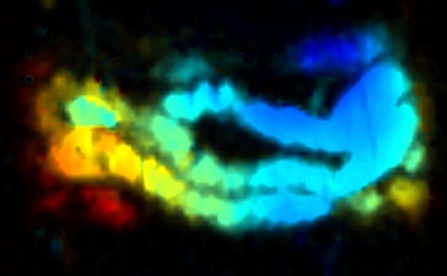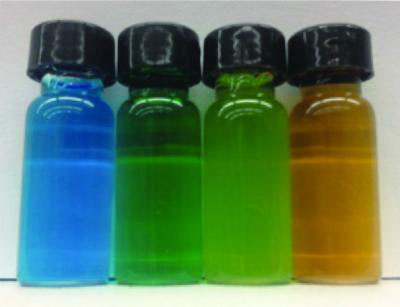‘Nanojuice’ could help diagnose gastrointestinal illnesses
August 20, 2014

The combination of “nanojuice” and photoacoustic tomography illuminates the intestine of a mouse (credit: Jonathan Lovell)
University at Buffalo researchers are developing a new imaging technique using nanoparticles suspended in liquid to form “nanojuice” that patients would drink to help diagnose irritable bowel syndrome, celiac disease, Crohn’s disease and other gastrointestinal illnesses.
Doctors would strike the nanoparticles, once they reach the small intestine, with a harmless laser light, providing an unparalleled, non-invasive, real-time view of the organ.
Described July 6 in the journal Nature Nanotechnology, the advancement could help doctors better identify, understand, and treat gastrointestinal ailments.
Limitations and risks with conventional imaging
Located deep in the human gut, the small intestine is not easy to examine. X-rays, MRIs and ultrasound images provide snapshots but each suffers limitations. “Conventional imaging methods show the organ and blockages, but this method allows you to see how the small intestine operates in real time,” said corresponding author Jonathan Lovell, PhD, UB assistant professor of biomedical engineering.
“Better imaging will improve our understanding of these diseases and allow doctors to more effectively care for people suffering from them.”
The average human small intestine is roughly 23 feet long and 1 inch thick. Sandwiched between the stomach and large intestine, it is where much of the digestion and absorption of food takes place. It is also where symptoms of irritable bowel syndrome, celiac disease, Crohn’s disease. and other gastrointestinal illnesses occur.
To assess the organ, doctors typically require patients to drink a thick, chalky liquid called barium. Doctors then use X-rays, magnetic resonance imaging, and ultrasound to assess the organ, but these techniques are limited with respect to safety, accessibility and lack of adequate contrast, respectively.
Also, none are highly effective at providing real-time imaging of movement such as peristalsis, which is the contraction of muscles that propels food through the small intestine. Dysfunction of these movements may be linked to the previously mentioned illnesses, as well as side effects of thyroid disorders, diabetes and Parkinson’s disease.
Packaging imaging dyes in harmless nanoparticles
Lovell and a team of researchers worked with a family of dyes called naphthalcyanines. These small molecules absorb large portions of light in the near-infrared spectrum, which is the ideal range for biological contrast agents.

Patients would drink the “nanojuice” (seen above) like water (credit: Jonathan Lovell)
They are unsuitable for the human body, however, because they don’t disperse in liquid and they can be absorbed from the intestine into the blood stream.
To address these problems, the researchers formed nanoparticles called “nanonaps” that contain the colorful dye molecules and added the abilities to disperse in liquid and move safely through the intestine.
In laboratory experiments performed with mice, the researchers administered the nanojuice orally. They then used photoacoustic tomography (PAT), which is pulsed laser lights that generate pressure waves that, when measured, provide a real-time and more nuanced view of the small intestine.
The researchers plan to continue to refine the technique for human trials, and move into other areas of the gastrointestinal tract.
Additional authors of the study come from UB’s Department of Chemical and Biological Engineering, Pohang University of Science and Technology in Korea, Roswell Park Cancer Institute in Buffalo, the University of Wisconsin-Madison, and McMaster University in Canada.
The research was supported by grants from the National Institutes of Health, the Department of Defense and the Korean Ministry of Science, ICT and Future Planning.
Abstract of Nature Nanotechnology paper
There is a need for safer and improved methods for non-invasive imaging of the gastrointestinal tract. Modalities based on X-ray radiation, magnetic resonance and ultrasound suffer from limitations with respect to safety, accessibility or lack of adequate contrast. Functional intestinal imaging of dynamic gut processes has not been practical using existing approaches. Here, we report the development of a family of nanoparticles that can withstand the harsh conditions of the stomach and intestine, avoid systemic absorption, and provide good optical contrast for photoacoustic imaging. The hydrophobicity of naphthalocyanine dyes was exploited to generate purified ∼20 nm frozen micelles, which we call nanonaps, with tunable and large near-infrared absorption values (>1,000). Unlike conventional chromophores, nanonaps exhibit non-shifting spectra at ultrahigh optical densities and, following oral administration in mice, passed safely through the gastrointestinal tract. Non-invasive, non-ionizing photoacoustic techniques were used to visualize nanonap intestinal distribution with low background and remarkable resolution, and enabled real-time intestinal functional imaging with ultrasound co-registration. Positron emission tomography following seamless nanonap radiolabelling allowed complementary whole-body imaging.